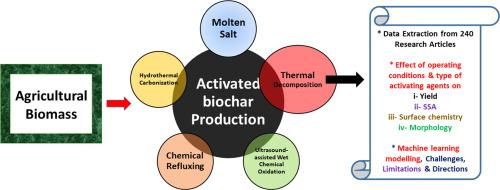A comprehensive insight on activated carbon production from agricultural biomass: Parametric analysis, challenges, future recommendations & machine learning modelling
IF 6.4
Q1 ENVIRONMENTAL SCIENCES
引用次数: 0
Abstract
The increasing accumulation of bio-waste poses significant environmental challenges worldwide. Sustainable and effective resource management is essential to restore ecosystems. Activated carbon produced from agricultural biomass through pyrolysis offers a sustainable solution to these issues. Therefore, this study provides detailed insights into the synthesis of activated carbon, highlighting critical parameters affecting the quality by extracting data from 240 published articles. The parametric analysis evaluates variables such as pyrolysis temperature, activation agent, and biomass type that impact the yield and specific surface area (SSA) of the synthesized activated carbon. Key findings reveal that optimizing pyrolysis conditions can enhance both yield and SSA. Furthermore, the paper presents the development of 03 different machine-learning regression models for predicting the performance of engineered biochar production by physical and chemical activation processes. This approach offers a dual benefit of waste reduction and resource efficiency by transforming agricultural waste into high-quality activated carbon. The study lays a foundation for further exploration of innovative applications, data science and advanced production techniques, aiming to make activated biochar production more environmentally friendly and economically viable.

对农业生物质活性炭生产的全面洞察:参数分析,挑战,未来建议和机器学习建模
生物废物的日益积累在世界范围内构成了重大的环境挑战。可持续和有效的资源管理对恢复生态系统至关重要。通过热解从农业生物质中生产的活性炭为这些问题提供了一个可持续的解决方案。因此,本研究通过提取240篇已发表文章的数据,对活性炭的合成提供了详细的见解,突出了影响质量的关键参数。参数分析评估了热解温度、活化剂和生物质类型等影响合成活性炭收率和比表面积(SSA)的变量。关键研究结果表明,优化热解条件可以提高产率和SSA。此外,本文还介绍了03种不同的机器学习回归模型的开发,用于预测通过物理和化学活化过程生产工程生物炭的性能。这种方法通过将农业废物转化为高质量的活性炭,提供了减少废物和提高资源效率的双重好处。该研究为进一步探索创新应用、数据科学和先进生产技术奠定了基础,旨在使活性生物炭生产更加环保和经济可行。
本文章由计算机程序翻译,如有差异,请以英文原文为准。
求助全文
约1分钟内获得全文
求助全文
来源期刊

Resources, conservation & recycling advances
Environmental Science (General)
CiteScore
11.70
自引率
0.00%
发文量
0
审稿时长
76 days
 求助内容:
求助内容: 应助结果提醒方式:
应助结果提醒方式:


